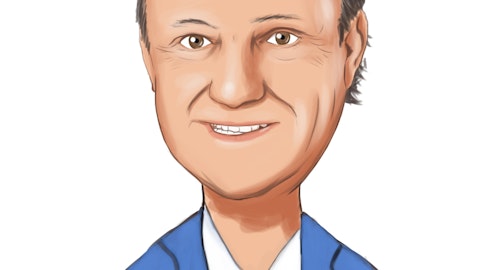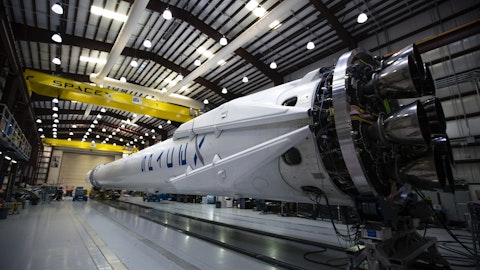Astronics Corporation (NASDAQ:ATRO) Q3 2022 Earnings Call Transcript November 15, 2022
Astronics Corporation misses on earnings expectations. Reported EPS is $-0.46 EPS, expectations were $-0.25.
Operator: Greetings. Welcome to the Astronics Corporation Third Quarter Fiscal Year 2022 Financial Results Conference Call. At this time, all participants are in a listen-only mode. A question-and-answer session will follow formal presentation. Please note this conference is being recorded. I will now turn the conference over to your host, Deborah Pawlowski. You may begin.

Photo by Alex Mihis on Unsplash
Deborah Pawlowski: Thanks Ciarmoli and good afternoon, everyone. We certainly appreciate your time today and your interest in Astronics. On the call here with me are Pete Gundermann, our Chairman, President and Chief Executive Officer; and Dave Burney, our Chief Financial Officer. You should have a copy of our third quarter 2022 financial results, which we released just after the market closed today. If you do not have the release, you can find it on our website at astronics.com. As you are aware, we may make some forward-looking statements during the formal discussion and the Q&A session of this conference call. These statements apply to future events that are subject to risks and uncertainties as well as other factors that could cause actual results to differ materially from what is stated here today.
These risks and uncertainties and other factors are provided in the release and with other documents filed with the Securities and Exchange Commission. You can find those documents on our website or at sec.gov. During today’s call, we will also discuss some non-GAAP financial measures. We believe these will be useful in evaluating our performance. You should not consider the presentation of this additional information in isolation or as a substitute for results prepared in accordance with GAAP. We have provided reconciliations of non-GAAP measures with comparable GAAP measures in the tables that accompany today’s release. So, with that, let me turn it over to Pete to begin. Peter?
Peter Gundermann: Thanks Debbie, and good afternoon, everybody. Thank you for tuning in to our call. Our agenda, as usual, will be mostly focused on a discussion of the recent quarter, the third quarter of 2022, and we will close with some forward-looking predictions for both the fourth quarter and an initial look at 2023. I’ll start and then I’ll pass it over to Dave, and then I will finish up again. So, when I look at the third quarter, I mean there’s a — at its basic — at its most basic, there’s a bad negative headline and there’s a pretty good headline. The bad headline is that the revenue ramp that we expected to begin in the third quarter was delayed. We did not get the ramp that we anticipated. The good news is that demand during the quarter in terms of bookings continues to be really strong, which sets us up again for a step change that we think is underway in the fourth quarter here in terms of volume and will carry into 2023.
So, first, let’s talk about the delayed revenue ramp, the negative headline. In my view, the third quarter was essentially a miss fire, like a full start in a race. We start — we would see revenue of about $150 million. Instead, we ended up at $131 million. That delay led to a reset of our second half expectations and was mostly driven by a combination of supply chain problems and program delays about 50/50. It also had the effect of delaying the expected ramp from the third quarter into the current quarter, the fourth quarter of 2022. So, a little detail on supply chain problems and program delays. The supply chain struggles are well documented, everybody’s experiencing them. I don’t plan to go into a whole lot of detail about them. But from our perspective, there are a couple of bright spots.
One is that when the supply chain problems became apparent in our economy, especially in our world of electronics in the middle and late second half of 2021, lead times stretched out dramatically. And we’ll talk in a minute about how demand has fluctuated for us over the pandemic. But basically, when demand came back in the second half of 2021, we started ordering parts that typically would have lead times of eight to 12, 14 weeks and all of a sudden, we’re getting quotes back at 52 weeks, which served to retard our ability to handle the surge in demand. Well, 52 weeks has come and gone, and those parts are now starting to come in. If you look at our inventory levels, in the most recent quarter, you will see that we’ve had a real buildup of inventory that obviously is bad news in terms of working capital, but it’s good news in terms of getting the parts that we’ve been waiting for, for about a year and which will set us up for the increased level of shipments that we anticipate in the current quarter and next quarter and the quarter after that.
The other thing is that we’re maybe a little bit of a contrarian here, but our perspective is that while supply chain has been a major disruption to our business and to many other businesses over the last a year and a half, we see signs of promise. We run a handful 12 or 13 different operations, and we do pretty systematic reviews and follow-up with them. And one of my regular questions is what’s the supply chain look like? Is it getting better? Is it getting worse? And for the first time in many quarters here, the feedback, the sentiment is that it’s not getting worse, maybe getting a little bit better, not across the board. We’re not out of the woods by any means, but it seems to have plateaued, and we are hopeful and optimistic that we’re going to continue to see lead times come down.
In some cases, pricing comes back to a more normal realm. And that’s a fundamental kind of expectation, not that things are going to snap back to perfect in the coming quarters, but that they’re not going to get any worse. We’re optimistic about that. I also want to talk a little bit about program delays. We have experienced a number of award delays that we thought were going to drive our second half that now look like they’re going to be delayed into 2023, maybe even in the late 2023. One example of that is the FLRAA award, which I’ve talked about in previous calls, future long-range of assault aircraft, the Army’s planned replacement for the Black Hawk. We’re teamed with Bell on their version of that, and Bell is competing with a team led by Sikorsky.
This is a program that most of the world expected to be awarded in kind of the May, June, July timeframe, then it flipped to October and here we are in November and maybe now it might happen by year-end. We — if Bell wins this program, we expect to play a major role in their team and it will be probably one of the — if not the largest, one of the largest programs that’s ever come to our company, and it will require a significant amount of engineering and development work. And we originally, when this thing was supposed to be awarded in May, June had a risk reduced amount included in our kind of budget and forecast for the second half of 2022. Obviously, that now at this point is slid out into 2023. Similarly, we made kind of a strange announcement on August 24 about a program called 4549/T, which is a radio test down select that we won from the U.S. Army.
The U.S. Army operates like 20 different radio types in their arsenal, a total of over 600,000 radios, and they ran a technical performance based competition between a number of suppliers, including us, to pick a platform to go forward with as their standard tester. We were selected as we hoped we would be, but we originally thought that this down select would happen early in the year, like in March or April, and then June, July. And then finally, we were selected in August. But even after being selected, now we have the opportunity to negotiate basically a directed procurement contract with the Army, which will take some time and means that what we had expected would be a solid contributor for the second half of 2022, will slide into 2023 and beyond.
It’s a significant program. And it’s all preliminary. We don’t know exactly how many and how many years this thing will go. But indications are that it will be a significant test contract for us to the tune we think of somewhere between $150 million and $200 million. So, between supply chain and program delays that in some cases were material, we had to reset our second half expectations. The third quarter also included some atypical costs, $4.6 million. Dave will talk about these in some more detail, but we exited or are exiting a long-term lease to building, which required some departure costs, a customer accommodation and a legal settlement, some of which we expect will be reimbursed in the fourth quarter. But the accounting rules say we take the cost in the third quarter and if we get reimbursed, and then we will happen in the fourth quarter.
And finally, of course, in the third quarter, like many companies or all companies were dealing with the effects of inflation on our production inputs. We are heartened by the recent news that maybe the inflation expectations are softening a little bit going forward. We think over time, we’ll be able to work this out like everybody else, stock price will come down, pricing and opportunities will go up to match the increase in costs, but it definitely had a negative impact on pricing or on margins in the third quarter. So, all this results in margin pressure, the lower volume, the elevated input cost, the atypical expenses, we ended up at the end of the day with an adjusted EBITDA of a negative 0.6%. The positive headline and its significant headline was continued strong demand in the market for our products.
We had third quarter bookings of $184 million. Again, against shipments of $131 million, that’s a book-to-bill of 1.4 and almost back to pre-pandemic levels. Pre-pandemic, the way the company is structured and was structured then, we would expect to book in most quarters somewhere between $190 million and $200 million. That was the trajectory we were on to come into $184 million. And if you look at the chart on the last page of our press release, you’ll see three out of the last four quarters, we’re right around $180 million. In fact, for the last four quarters, we had bookings of $685 million against shipments of $493 million. So, that’s a book-to-bill of 1.39 leaves us with another record backlog of $547 million, our highest ever. Before I turn it over to Dave, I wanted to define or — we get these questions every once in a while, about how we count bookings, how do we define a bookings.
And it’s a pretty conservative measure that we use. Basically, we need a delivery order with a firm price and a firm delivery date before we call it a booking. So, we exclude blanket orders or long-term agreements that don’t have specific pricing determinations or delivery deadlines. So, I use the 737 MAX, as an example, it’s one of our historically largest production programs coming back, thankfully. We put a certain amount of product on every airplane, and we have long-term agreements with Boeing for that book of business that stretches out for years. And one way to count bookings would be to look at the term of the agreement, say the 2027 or 2025 or whatever the case may be and look at their skyline production chart and multiply the two together and call that backlog, that’s not how we do it.
In that case with 737 and Boeing, for example, they give us delivery orders on a regular basis, say each quarter for delivery for the next quarter. And that amount is — which is defines exactly what the product is and what the pricing is and what the delivery deadlines are, that’s what we include as a booking, nothing more. So, we’re pretty consistent with that. And I think helps people understand what true demand is for our business without getting messed up with long-term agreements and long-term assumptions that might go along with it in some cases. So, again, great bookings for the third quarter, a continuation of great bookings for the last — really the last five quarters, and we think that sets us up for a good short-term future here going into wrapping up 2022 and going into 2023.
At this point, I’ll turn it over to Dave to go over some of the specifics of the third quarter. Dave?
See also 10 Most Overvalued Companies and 11 Best High Dividend Stocks.
David Burney: Thanks Pete. While our sales continue to improve, we continue to experience margin and cash flow headwinds as well as $4.6 million of what I call atypical costs in the quarter. Consolidated sales increased to $131.4 million and was led primarily by continued growth in the recovering commercial transport market, which was up 36% compared with last year’s third quarter and up 13% sequentially from the second quarter. General Aviation sales increased by $2.6 million to $14.8 million due to increased volume, primarily of our antenna sales and enhanced vision systems into that market, while military aerospace sales decreased by $4.6 million to $12.5 million due primarily to a reduction in non-recurring engineering revenue compared with the prior year.
Test segment sales increased by $3.2 million to $19.3 million and was driven by increased instrument test and transit test volume. Despite this top line growth, we continue to struggle with our margins. The sales increase of $19.6 million compared to the previous year’s quarter. Historically, we would expect to see 40% to 45% of that sales increase or about $8 million or so drop to operating profit. But we didn’t see that. We saw our operating loss from operations actually increased by $9.8 million from a loss of $4.5 million to a loss of $14.3 million. So, here are some of the items and the headwinds that happened during the quarter compared to a year ago. Continued high level of spot buys to source inventory. This is estimated to cost us about $4 million during the quarter.
We expect these types of buys to continue, but to wind down as we move through the next 12 months as supply chain improves. We have several atypical costs that do not — we do not expect to continue to be recurring in the future, including $4 million to settle ongoing legal dispute and customer accommodation. We do, however, as Pete mentioned, expect that will be indemnified for a portion of these costs in the future. Additionally, $450,000 in lease termination costs were accrued as we’re relocating our Irvine test operation into a different location in Irvine. Inflation’s impact relating to material and labor cost is estimated to be in the range of 7% to 8% or about $8 million to $9 million for the quarter compared to a year ago. We expect, over time, we’ll be able to pass these costs to our customers as we enter into future contracts, but there will be a lag.
Some contracts have been renewed with more favorable pricing and some are in the works and some will not open up for another year or two, but we are working on those. Additionally, we’ve not been realizing customary margins on several of our newer test segment development programs. We do expect higher margins on the follow-on orders relating to those development programs that we’ve received or expect to receive in the future. And finally, in last year’s third quarter, we did recognize $1.1 million of grant from the AMGP program, offsetting cost of goods sold that we don’t have this year. Switching to the balance sheet. We had a difficult quarter with respect to cash. Our net debt was $156 million at the end of the quarter, up $133 million at the beginning of the year.
Cash flows from operations in the third quarter were negative $28.8 million, largely caused by inventory, which increased $16.1 million during the quarter, driven again — once again by our growing sales backlog and the move to the right of some sales programs and complicated by supply chain inefficiencies. Receivables growth also increased by $16.7 million during the quarter, and this was compounded by the negative EBITDA margins that we had in the quarter or basically breakeven EBITDA margins in the quarter. We did have — we do have some progress to report in terms of an amended credit facility that we completed yesterday. With the cooperation of our bank group, we extended the expiration of the revolving credit facility, this time to the end of November 2023.
The extension will provide more time to get a long-term credit arrangement in place as the process has been moving slower than expected. You may recall that three months ago when we reported, we were targeting having this done by now. While we’re not finished yet, we once again, we’re maybe still in the final stretch and expect that we’ll have a new facility in place before the end of the year. Some select changes to the terms of the revolver. The revolver will remain at $180 million through December 20 then decreased to $170 million. The sulfur pricing spread will increase to SOFR plus 550 basis points through January 16, then increased to SOFR plus 850 basis points thereafter. We are required to maintain trailing 12-month adjusted EBITDA of $15 million for the quarter ending December 31 and March 31, then $25 million for the remaining quarters thereafter.
Minimum liquidity through December 31, measured monthly is required to be $10 million, increasing to $15 million thereafter. And there was a 10 basis points amendment fee. Pete, that’s all I have.
Peter Gundermann: Okay. So, for the rest of this — for now, I’d like to suggest that you turn your attention to the bar chart on the last page of the press release. I’m going to talk about this a little bit to explain kind of where we’ve been and where we’re going as a company through the COVID period here. And what you have there, hopefully, you’re looking at a color version rather than a black and white version. But for each of the quarters from the first quarter of 2020 through the last quarter, third quarter of 2022, the bar on the left or the green bar, if you’re looking at is our bookings for that quarter and the blue bar at the bar on the right, is our shipments. I’m going to first focus on the left bars or the green bars, the booking trends.
And you can see that when the lockdown happened in the first and second quarter of 2020, our bookings went off a cliff, and we basically went from $165 million, $166 million down to $60 million. And then it climbed back kind of quickly, but to a reduced level at a plateaued right around $120 million for three quarters. That was largely a period of restricted travel and lockdown work from home, all that stuff. You might remember from COVID. Then about a year ago, in the third quarter of 2021, when those lockdowns were lifted, demand took off. First narrowbody. We’re not talking about it a whole lot on this call, but we’re seeing many signs of increased widebody travel also these days, which is very exciting. And bookings took off up to $160 million, $180 million in the last quarter at $184 million.
So bookings, again, bouncing back pretty quickly, especially over the last year. The blue bars, the bars on the right reflect our shipments, and we fell and followed bookings down for a couple of quarters, bottoming out in the third quarter of 2020. And then kind of plateauing basically about $100 million to $120 million level up until two quarters ago, when we kind of broke through $120 million, broke through $130 million, but still obviously over the last year lagging demand significantly. And that’s really when the supply chain problems with the world happen. That all happened around the third quarter of last year, second quarter of last year, demand took off, and we had a hard time matching it, and we’re still struggling to do so. But we were ordering materials way back then and those materials are starting to come in.
Dave talked about the inventory ramp and it gives us confidence that we can execute on the orders in front of us going forward. So, again, if you look at the last four quarters, we had total bookings of $685 million against sales of $493 million. Sales have to catch up. That’s our mission. That’s our challenge. So what are our expectations? We are expecting that fourth quarter revenue, the quarter we’re in right now, will be in the range of $140 million to $150 million. We’re aiming for the high-end of that range. We have some challenges, but we think that’s a safe range. And as of our most recent reading, we are on track to do that from a volume standpoint in the current quarter. Looking forward, it’s typical this time of the year, we take a first look at the year that’s coming, and we are kind of working on but finishing up our budgeting process for 2023.
Based on bookings that we’ve experienced to date and the record backlog that we have of $547 million, we think that we’re going to be in the range of $640 million to $680 million next year. And that would represent a significant level of growth over where this year is going to end up, which will be in the $525 million, $530 million range. So that’s a big challenge. It’s largely dependent on getting the parts that we need. But our indications are that the supply chain is loosening up in any event is not getting any worse. So, we think that we have the planning in place to bring those parts in house and then convert them into revenue. And we think it’s going to be a really good year. Obviously, we’ll update more on that as we get closer and get into it.
And there are some things that are important to get nailed down like FLRAA and 4549/T. But we think we have the pieces in place to make that year a reality. So I think that ends our prepared remarks. Sean, I’d like to open it up to questions at this point.
Q&A Session
Follow Astronics Corp (NASDAQ:ATRO)
Follow Astronics Corp (NASDAQ:ATRO)
Operator: And our first question comes from the line of Jonathan Tanwanteng with CJS Securities. Please proceed with your question.
Jonathan Tanwanteng: Hi. Good afternoon, guys. Thanks for taking my questions. I was just wondering, does the inventory that you’ve built give you that confidence to shift to your revenue guidance? Or do you — are you still waiting on parts that could push out things towards the end of the quarter?
Peter Gundermann: Are you talking about the fourth quarter, Jon?
Jonathan Tanwanteng: Yes, correct.
Peter Gundermann: We think we have pretty good line of sight to inventory for the fourth quarter. There are a couple of hotspots. There always are. And we’re working those pretty aggressively. But our internal target is at the high-end of that range or just beyond it. And so, by putting that range in there, we think we’re giving reasonable allowance for material problems that could still pop up. But at this point, we’re obviously pretty well into the quarter and we’re encouraged that we’re on track so far. So, we think we’re all right.
Jonathan Tanwanteng: Okay. Great. Dave, I was wondering what your new estimate of when you might achieve breakeven just on a pretax income or a cash flow basis, just given the inflation underlying, the push out of the ramp and obviously, your expectations for how the refinancing might play out?
David Burney: Yeah. I think our quarterly GAAP pretax breakeven points in the neighborhood of $160 million when the spot buys go away. We experienced $3 million or so in spot buys this quarter. So with those, I’d say our GAAP breakeven point is probably about $165 million right now with those spot buys.
Jonathan Tanwanteng: Okay. Great. And then just any best estimate for what’s left to complete the refinancing? What are the items left and kind of the time that you think it will take?
David Burney: Well, our target is to get something done before year-end here. We’re working with a couple of options there in terms of — it’s still basically the same structure we talked about before with a combination of an asset-based loan that’s supported by working capital, receivables and inventory and the term loan that would be supported by real estate and machinery and equipment, same basic structure there. And target is to get it done as soon as possible. And I’m confident we’ll get something done in the first half of December, but the — if you read through the amend and extend — the amendment we just did, it’s highly in our benefit to get something done sooner rather than later. So, it’s — I’m confident we’ll get something done in December here.
Jonathan Tanwanteng: Okay. Great. Good luck. Thank you.
Operator: Our next question comes from the line of Michael Ciarmoli with Truist. Please proceed with your question.
Michael Ciarmoli: Hey, good evening guys. Thanks for taking the question. Dave, maybe just to stay on the credit facility. What — and you mentioned the EBITDA levels on a trailing basis. It sounds like you won’t be EBITDA positive in the fourth quarter, but what sort of the bank definition of EBITDA, what was sort of the bank defined EBITDA this quarter? And how do you — it just sounds like there’s going to be a challenge to get to a sustaining EBITDA level here?
David Burney: I would say that we will be cash or EBITDA positive in the fourth quarter. So, our forecast has us being compliant.
Michael Ciarmoli: Okay. Even though you just said — breakeven?
David Burney: Michael, with that we wouldn’t have entered into an amendment that we were forecasting to not be compliant with.





